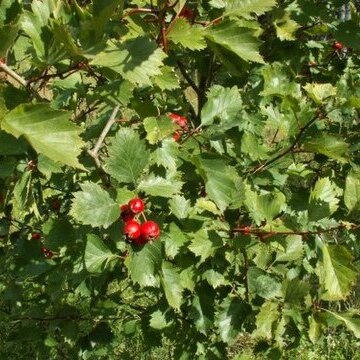Shrubs or trees, 40–50 dm. Stems: twigs: new growth reddish at first, usually sparsely pubescent, 1-year old deep chestnut brown, older dull gray; thorns on twigs 1-year old shiny, dark brown, stout to slender, 4–6 cm. Leaves: petiole ?1–2 mm wide?, length 40–50% blade, glandular; blade ?glossy, dark green?, broadly elliptic to ovate, 4–7 cm, base cuneate to slightly rounded, lobes 4 or 5 per side, sinuses deep, lobe apex acuminate, margins sharply serrate, ?teeth gland-tipped?, veins 5 or 6 per side, apex acute, ?abaxial surface glabrous except along veins?, adaxial densely appressed-scabrous young, glabrescent. Inflorescences 5–10-flowered; branches villous; bracteole frequency not recorded, linear. Flowers 13–17 mm diam.; hypanthium glabrous or villous at base; sepals 4–5 mm, margins entire, glandular to glandular-serrate, rarely nearly eglandular, ?apex acute?, abaxial pubescence not recorded; stamens 5–10 or 20, anthers usually pink; styles 3–5. Pomes crimson, ± ellipsoid, 8–10 mm diam., ?sometimes ± pruinose?; sepals spreading or usually erose, ?not or obscurely elevated?; pyrenes 3–5, dorsally deeply grooved. 2n = 51.
More
A shrub or very small tree. It grows 5 m tall. It is very thorny. The leaves are 5 cm long. They have 7-13 sharp lobes. The lobes have several small sharp teeth along the edge. The leaf stalks are grooved above and have wings. The thorns are slender and 5-6 cm long. They are slightly curved. The fruit are bright red and 8-10 mm across. They have thick flesh.
Thickets and open woods. Dry open places, borders of woods and the margins of high banks of streams. Brush, successional fields, fencelines, woodland edges, open woodlands; at elevations tp to 200 metres.
More
Temperate. It grows on rocky upland soils and on the edges of forests.


